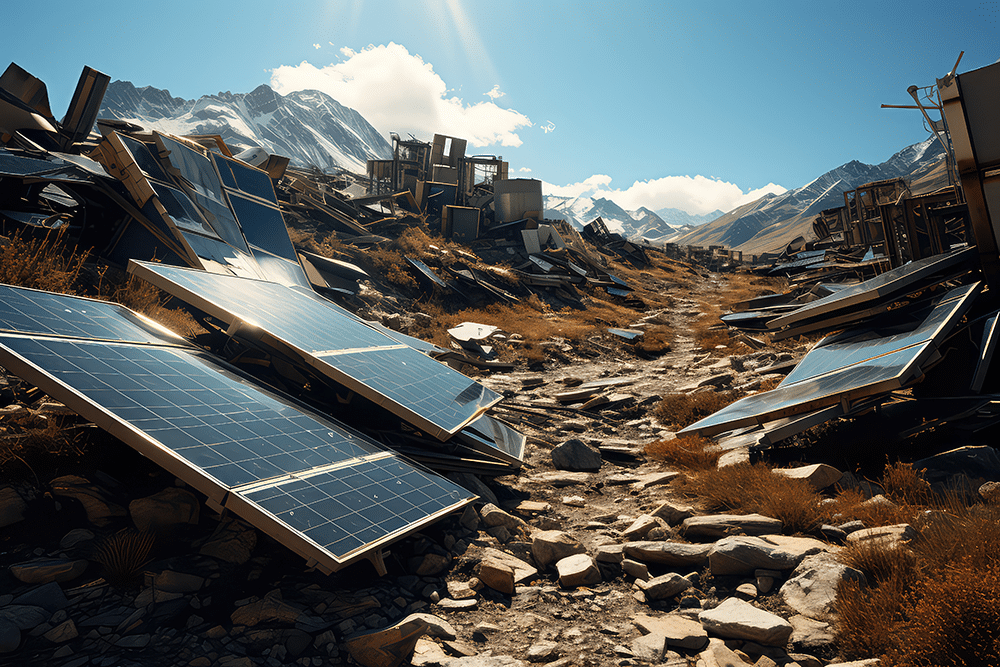Renewables/GOES MMI: The “Dirty” Business of Disposing of Solar Panels

Numerous factors continue to pull at the Renewables MMI (Monthly Metals Index) as it moves through Q1. This past month, the index largely moved sideways, only exhibiting a slight upward movement of 1.66%. Meanwhile, renewable energy news indicated that metals like cobalt and silicon could remain in oversupply for some time. Moreover, expanding mining operations in DRC continue to add cobalt to the already-abundant global stockpile. With steel prices flattening, the index continues to move steadily sideways.
Understand how metal market volatility affects your earnings on a monthly basis. Boost your financial power with MetalMiner’s Monthly Metals Outlook report. Dive in with a free sample report.

Solar Panels: A “Dirty” Truth?
Despite being made to survive for many years, all solar panels, like most things, eventually lose their usefulness. At that point, owners need to dispose of them in a way that does the least amount of damage to the environment. In addition to components that are potentially dangerous for human consumption, like lead and cadmium, solar panels utilize a variety of other materials, such as glass, aluminum, and silicon. Some of these materials can pose threats to the environment if improperly handled and thrown into landfills.
To solve this problem, many nations and areas have put laws and standards in place regarding the appropriate disposal of solar panels. For example, the Waste Electrical and Electronic Equipment (WEEE) directive from the European Union lays out precise guidelines for the gathering, handling, recycling, and recovery of solar panels.
Meanwhile, the U.S. Resource Conservation and Recovery Act (RCRA) regulates the handling and disposal of many hazardous wastes, including some kinds of solar panels.

Numerous countries and regions require solar panel recycling to ensure proper disposal, recover valuable materials, and minimize the quantity of garbage dumped in landfills. For this reason, people and organizations that install and maintain solar panel systems must understand their accountability for ensuring appropriate disposal.
Laws, Meet Reality
Despite these laws and regulations, data indicates that less than 10% of the United States’ decommissioned panels are recycled. Likewise, the recycling rate of solar panels in the European Union is about 10%, despite EU law mandating that solar panel producers recover a minimum of 80% of each panels’ mass. To make matters worse, solar panel recycling efforts remain in the early stages and may not advance fast enough to cancel out the damage done.

Due to the presence of substances that are potentially harmful for human consumption, such as lead and cadmium, proper disposal remains vital. Many renewable energy news outlets warn that some owners may discard solar panels as solid trash when they are no longer functional. According to estimates from the International Renewable Energy Agency (IRENA), the world could contain 78 million metric tons of garbage from solar panels alone by 2050.
Whatever the case, it remains critical to ensure solar panels are recycled or stored appropriately to avoid their ending up in landfills and doing long-term environmental harm.
Other Renewable Energy News: Lack of Space for Wind and Solar?
Concern over the lack of available land for wind and solar energy projects continues to grow as the globe looks toward renewable energy sources. Indeed, one of the biggest obstacles to these technologies’ broad acceptance is the requirement of vast tracts of land for their deployment. The primary concern is that other land uses, such as agriculture and conservation, may face competition from this need for land.
Nonetheless, the search to find suitable land for wind and solar projects continues worldwide, particularly as nations work to achieve their climate commitments and move away from fossil fuels. As a result, large-scale renewable energy projects might could cause issues over land usage.

Moreover, the scarcity of appropriate land in areas of dense population remains a major obstacle to the widespread development of solar and wind energy. Still, many green energy proponents continue to investigate novel approaches to maximizing the utilization of scarce land resources for wind and solar energy and overcoming these issues.
Examples include creating cutting-edge technology like solar panels that float and can be installed on bodies of water, or incorporating solar panels into existing structures like transportation networks and buildings. Similarly, wind turbine installation and design improvements strive to maximize energy output while reducing their negative effects on land usage.
Knowledge is key in navigating metal market fluctuations. Don’t miss out on MetalMiner’s expert analysis and up-to-date information. Opt into MetalMiner’s free weekly newsletter.
Grain-Oriented Electrical Steel MMI
Volatility remains the name of the game when it comes to grain-oriented electrical steel prices. After seeing a rise between December 1 and January 1, prices fell alongside most other forms of steel. While Chinese GOES prices recently hit their lowest point since 2017, European GOES remain well within support and resistance zones, and U.S. GOES recently breached resistance zones.
Overall, the Grain-Oriented Electrical Steel MMI fell a total of 17% month-on-month.

Renewables MMI: Notable Price Shifts
MetalMiner’s MMI report includes 10 metal price reports and can be used as an economic indicator for contracting, price forecasting and predictive analytics. Sign up here.
- Chinese silicon prices dropped in price by 5.15%, leaving
- Chinese cobalt prices moved sideways month-on-month, moving down 2.36%, which left prices at $28.34 per kilogram
- Finally, Korean steel plate prices moved sideways, only dropping in price by 1.35%. This left prices at 802.97 per metric ton


